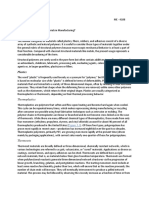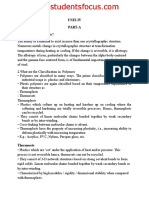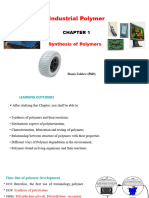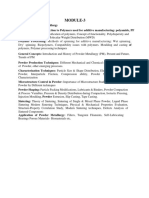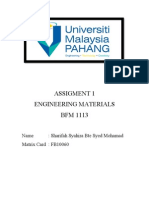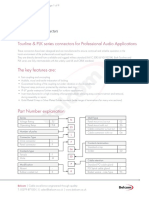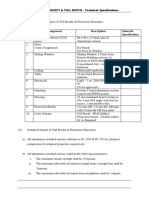SLG Chem 3 LG 5.12 Industrial Application of Polymers
SLG Chem 3 LG 5.12 Industrial Application of Polymers
Uploaded by
franzachilleslindayagCopyright:
Available Formats
SLG Chem 3 LG 5.12 Industrial Application of Polymers
SLG Chem 3 LG 5.12 Industrial Application of Polymers
Uploaded by
franzachilleslindayagCopyright
Available Formats
Share this document
Did you find this document useful?
Is this content inappropriate?
Copyright:
Available Formats
SLG Chem 3 LG 5.12 Industrial Application of Polymers
SLG Chem 3 LG 5.12 Industrial Application of Polymers
Uploaded by
franzachilleslindayagCopyright:
Available Formats
Subject Code Chem 3 Reactions and Interactions of Organic and Inorganic Compounds
Module Code 5.0 Biomolecules II
Lesson Code 5.12 Industrial Application of Polymers
Time Limit 30 minutes
TA AT
Components Tasks a
Ab
Target The target of this learning guide is to: 0.5
1) Describe how polymers are designed for specific purposes such as min
adhesives and conducting polymers.
1.5
Hook Thousands of businesses operate in the synthetic polymer industry today. min
Manufacturers, processors, fabricators, and finishers are some of the functions
of these companies that involve polymers (Carraher, 2013). A wide range of
polymers are used in the industrial manufacture of plastics, elastomers,
fabrics, adhesives, and surface coatings. These compounds can be classified
in a variety of ways. Polymers can be classified according to mode of
assembly (i.e. chain-growth or step-growth) (Solomons et al., 2016).
Polymers can be classified based on the intermolecular forces present (e.g.
elastomers, fibers, thermoplastics, thermosets, etc.). Polymers may seem to be
a very industry-specific topic, and they are to some extent, but they are a
significant part of a number of industries that you may be familiar with. In
this learning guide, we will describe how polymers are designed for specific
purposes such as adhesives and conducting polymers.
18
Ignite Adhesives min
The word "adhesive" refers to a wide range of substances that are used to
adhere one material to another via surface attachment. An "adhesive joint" or
"adhesively bonded assembly" is formed when two "adherends" are connected
by an "adhesive." Adhesive technology also is a "joining technology" just like
screws, nuts and bolts, rivets, brazing, and welding. Most adhesives are made
up of organic components that are either polymers or react to form polymers
(Mark, 2007). The Egyptians used resinous adhesives to bind ceramic vessels
at least 6,000 years ago. Other adhesives (e.g. starch, milk, and glues from
animals and fish) were first used at least 3,500 years ago (Carraher, 2013).
Multiple mechanisms contribute to adhesion. Mechanical adhesion with
interlocking occurs as the adhesive mixture passes through and into two rough
substrate faces. Similar to a hook and eye, the stiff plastic hooks become stuck
in the fuzz-like labyrinth of more flexible threads or fibers. The bonding of
primary chemical groups is known as chemical adhesion. Specific or
secondary adhesion occurs when hydrogen or polar bonds are formed.
Viscosity adhesion is defined as adhesion where mobility is restricted due to
the viscous characteristic of the adhesive material (Carraher, 2013).
Adhesives are categorized according to the type of adhesive delivery or the
type of polymer used in the adhesive. The following are some of the several
types of adhesives that are currently available in the market.
Solvent-based adhesives: They adhere to the substrate by the action of the
adhesive. The evaporation of the solution causes solidification. Bonding is
assisted when the solvent interacts with the substance in some way, or, in the
Chem 3 LG 5.12 Biomolecules II: Industrial Application of Polymers Page 1 of 4
case of model airplane glues and PVC piping glues, dissolves some of the
plastic. Volatile solvents in model airplane glues and PVC glues, for example,
melt the plastic, resulting in a solvent weld. To aid in the production of a
successful weld, several PVC glues contain dissolved PVC. The addition of
color to commercial PVC glue allows building inspectors to readily
differentiate the application, which is a crucial difference between home-use
and industrial PVC adhesive.
Latex adhesives: They're made up of polymer latexes that need to be above
their Tg (see note below) to flow and maintain good surface contact when
water evaporates. It's usual that latex adhesives use the same polymers as latex
paints. Latex adhesives are often used to adhere pile to carpet underside or
backing.
Note: Tg, or the Glass Transition Temperature, is the temperature when an
amorphous polymer's structure becomes "viscous liquid or rubbery" when
heated. It's also the temperature at which an amorphous polymer develops
glassy-state characteristics including brittleness, stiffness, and rigidity (upon
cooling).
Pressure-sensitive adhesives: When exposed to pressure, they are viscous
polymers that melt at room temperature. To allow rapid flow, the application
of polymers must be above their Tg. The adhesive will flow if you apply
pressure on it. The viscosity of the polymer is adequate to retain and bind to
the surface until the strain is removed. Many tapes are of this kind, with a
smooth back and a nonpolar coating to prevent bonding with the surface that
sticks. It is feasible to separate the two clinging surfaces, although it is
difficult.
Hot-melt adhesives: They are thermoplastics that melt and then cool to
produce efficient adhesives once the plastic has filled surface gaps. Nylons
are widely utilized in this way as well as electric glue guns.
Reactive adhesives: Polymerization and/or cross-linking processes harden
low molecular weight polymers following application. Cyanoacrylates,
phenolics, silicon rubbers, and epoxies are examples of this type of glue.
Plywood is created by impregnating thin sheets of wood with resin after it has
been put between the wooden sheets.
Contact adhesives: Before pressing the surfaces together, they are normally
applied to all of them. Contact adhesives in the automotive industry are liquid
copolymers of butadiene and acrylonitrile containing carboxyl end groups.
Anaerobic adhesives: They are made up of a mix of dimethacrylates and
hydroperoxides (initiators) that polymerize without oxygen. They are used to
keep bolts in place.
Chem 3 LG 5.12 Biomolecules II: Industrial Application of Polymers Page 2 of 4
Conducting Polymers
The material and the conductor have an effect on conductance behavior.
Polymeric materials, in contrast to metals, are poor conductors of sound, heat,
electricity, and applied forces. Common polymers can be used to convey and
"mute" these variables. As force is applied, a polymer network, for example,
transfers forces between neighboring sections of the polymer chain and
adjoining chains. Because the polymer matrix or arrangement is rarely as
tightly packed as a metal, the various polymer units are able to absorb as well
as transfer this energy. Some physical forces' comparatively low conductance
can be explained in the same way. Nonetheless, polymers may be engineered
to compete in conductance with metals and other non-polymer materials
(Carraher, 2013). Some of these are listed below.
Photoconductive and Photonic Polymers: When exposed to light, certain
polymeric materials become conductive. In the dark, poly(N-vinylcarbazole)
is an insulator, but when exposed to UV rays, it becomes conductive. By using
electron acceptors and sensitizing dyes, the photoconductive response can be
extended into the visible and near-infrared ranges. The ability of a material to
absorb light and form free-charge carriers, or electron holes, as well as the
ability to "move" or "jump" these carriers when a current is applied, is what
defines photoconductivity. Photo-responsive sunglasses are nonlinear optical
materials that change tint or color based on the strength of sunshine. Some
"smart" windows are built of polymeric materials that change color based on
how much light they receive.
As polymer-intense semiconductor devices, standard transistors and field-
effect transistors (FETs), as well as photodiodes and light-emitting diodes
(LEDs), have all been researched. The electrical character of these materials,
especially conductive polymers, are attributed to their presence of a
conjugated pi-bonding system.
Electrically Conductive Polymers:
Conjugated double bonds are an essential structural characteristic of
conductive polymers. A stronger localized sigma-bond connects each
carbon backbone in polyacetylene. They are also linked by a chain of
alternating less localized and weaker pi-bonds. Though conjugation is present,
the pi-bond electrons are sufficiently localized to avoid delocalization.
Dopants introduce sites of increased or decreased electron density. When an
electron deficiency, or void, forms, electrons flow to fill it, prompting more
electrons to flow to fill the new hole, and so on, allowing charge to flow inside
and between the polyacetylene chains.
Conducting polymers have a lot of promise as corrosion-resistant coatings.
Polyaniline's ability to protect against corrosion, for example, is pH based.
Polyaniline-coated steel corrodes 100 times slower than non-coated steel at
lower pHs. At a pH of about 7, the corrosion resistance period for polyaniline-
coated steel is just twice as long. Making solid-state rechargeable batteries
and electrochromic cells is another area of use. Thousands of cycles have been
Chem 3 LG 5.12 Biomolecules II: Industrial Application of Polymers Page 3 of 4
performed on polyheterocycles, with certain materials retaining more than
50% of their electrochromic activity after 10,000 cycles. Polyaniline-based
infrared polarizers have proven to be as effective as metal wire polarizers.
They're also utilized in nonlinear optical devices such as optoelectronics,
which can be used in signal processing and communication.
8
Navigate (Graded Assessment) Adhesives and conducting polymers are just two of the min
polymer technologies that exist today. Cite three (3) more industrial
applications of polymers. Describe their applications and how they are
designed.
2
Knot NOTE TO THE TEACHER: This is just a suggested alternative activity/ min
assessment tool that may or may not be accomplished.
Go to https://1lib.ph/book/2837102/999612
Download the e-book entitled “Polymers for personal care products and
cosmetics”. Describe how polyacrylates are used for personal care.
a – suggested time allocation set by the teacher
b – actual time spent by the student (for information purposes only)
References:
Carraher, C. E. (2013). Introduction to polymer chemistry (3rd ed.). CRC Press.
Mark, J. E. (2007). Physical properties of polymers handbook (2nd ed.). Springer Science &
Business Media.
Solomons, T. W., Fryhle, C. B., & Snyder, S. A. (2016). Organic chemistry (12th ed.). John
Wiley & Sons, Inc.
Prepared by: Mark Merrill N. Mesa Reviewed by: Brenda A. Pelagio
Position: Special Science Teacher III Position: Special Science Teacher IV
Campus: PSHS-CVC Campus: PSHS-CLC
© 2020 Philippine Science High School System. All rights reserved. This document may contain proprietary information and may only be
released to third parties with approval of management. Document is uncontrolled unless otherwise marked; uncontrolled documents are not
subject to update notification.
Chem 3 LG 5.12 Biomolecules II: Industrial Application of Polymers Page 4 of 4
You might also like
- Adhesive Theory N TypesDocument11 pagesAdhesive Theory N TypesgautamahujaNo ratings yet
- MEMSDocument21 pagesMEMSScientist SakthivelNo ratings yet
- Mee 402 Act 1Document9 pagesMee 402 Act 1Missy ForlajeNo ratings yet
- Application and Processing of PolymerDocument38 pagesApplication and Processing of PolymerJohn Mark Manalo RosalesNo ratings yet
- A Designers' Guide To Engineering Polymer TechnologyDocument11 pagesA Designers' Guide To Engineering Polymer TechnologyNataly Calderon100% (1)
- AdhesivesDocument38 pagesAdhesivesManish Singh100% (9)
- Introduction To PolymersDocument20 pagesIntroduction To PolymersHayyaAliNo ratings yet
- Conductive Materials For ESD Applications: An Overview: Robert B. RosnerDocument8 pagesConductive Materials For ESD Applications: An Overview: Robert B. RosnerYousaf KhanNo ratings yet
- Elastic Vitrimers BeyondDocument32 pagesElastic Vitrimers BeyondMostafa AhmadiNo ratings yet
- A Composite Is Any Material Made of More Than One ComponentDocument10 pagesA Composite Is Any Material Made of More Than One ComponentKingchemNo ratings yet
- Unit-Iv Part-ADocument7 pagesUnit-Iv Part-AParameswara RajaNo ratings yet
- AppliedDocument3 pagesAppliedYopiWindaSariNo ratings yet
- CHAPTER 1 and 2 Synthesis of Polymers - 2023Document106 pagesCHAPTER 1 and 2 Synthesis of Polymers - 2023abdisahurisa24No ratings yet
- Unit VDocument20 pagesUnit VMECH HODNo ratings yet
- Module-3 Additive Manufacturing 18 SchemeDocument62 pagesModule-3 Additive Manufacturing 18 SchemeSANTOSHNo ratings yet
- 10 5923 J Ajps 20140402 01 PDFDocument7 pages10 5923 J Ajps 20140402 01 PDFBen ClarkeNo ratings yet
- ACI 503.5 (R2003) Guide For The Selection of Polymer Adhesives With ConcreteDocument16 pagesACI 503.5 (R2003) Guide For The Selection of Polymer Adhesives With ConcretephilipyapNo ratings yet
- Properties of Polymers.Document7 pagesProperties of Polymers.chaudharyeshank1No ratings yet
- What Is A Polymer CoatingDocument14 pagesWhat Is A Polymer CoatingGvsr SunnyNo ratings yet
- Physical Properties and Applications of Conducting Polymers: An OverviewDocument11 pagesPhysical Properties and Applications of Conducting Polymers: An Overviewعمرو محمدNo ratings yet
- Assignment 03 by AlemuDocument11 pagesAssignment 03 by AlemuAlemu MergaNo ratings yet
- Assigment 1 Engineering Materials BFM 1113: Name: Sharifah Syahira Bte Syed Mohamad Matrix Card: FB10060Document19 pagesAssigment 1 Engineering Materials BFM 1113: Name: Sharifah Syahira Bte Syed Mohamad Matrix Card: FB10060Sharifah Leha100% (1)
- Tire Cord TheoryDocument29 pagesTire Cord TheoryMarcus NguyễnNo ratings yet
- 2Document13 pages2VNSAramakiNo ratings yet
- Nikunj 17Document23 pagesNikunj 17Tvarit PatelNo ratings yet
- Assignment 03 by AlemuDocument11 pagesAssignment 03 by AlemuAlemu MergaNo ratings yet
- Session 2023 2024Document10 pagesSession 2023 2024ananddevsinghparihar2No ratings yet
- Adhesive BondingDocument26 pagesAdhesive BondingmaniNo ratings yet
- Plasticizing Agents Advantage: PlasticizersDocument3 pagesPlasticizing Agents Advantage: Plasticizersdanena88No ratings yet
- PresentationDocument13 pagesPresentationYash Deep KumarNo ratings yet
- Unit IV PolymerDocument25 pagesUnit IV PolymerYugandhar PatilNo ratings yet
- Unit 3 Civil Mech, Unit 4 Eee and Ece Polymer TechnologyDocument57 pagesUnit 3 Civil Mech, Unit 4 Eee and Ece Polymer Technologymaheshbabugandupalli7No ratings yet
- TMCE2014Controlledpolymerrecyclinganddegradation FinalDocument16 pagesTMCE2014Controlledpolymerrecyclinganddegradation FinalGyörgy BánhegyiNo ratings yet
- Polymer: Types of PolymersDocument6 pagesPolymer: Types of PolymersSarah SheikhNo ratings yet
- Icee PaperDocument4 pagesIcee PaperHarshith Kumar hvNo ratings yet
- Guide For Polymer Adhesives With Concrete The Selection Of: (Reapproved 1997,2003)Document16 pagesGuide For Polymer Adhesives With Concrete The Selection Of: (Reapproved 1997,2003)anhxuanqbNo ratings yet
- 06 - Chapter 1 PDFDocument42 pages06 - Chapter 1 PDFjoeNo ratings yet
- Important For This InventionDocument13 pagesImportant For This InventionAvinash SrinivasNo ratings yet
- Project On PolymerDocument18 pagesProject On Polymermfayaq1100% (1)
- Module 15 - UNIT III - PolymersDocument12 pagesModule 15 - UNIT III - PolymersJhess GaliciaNo ratings yet
- Polymers: Thermoplastics Thermosets Elastomers Synthetic FibersDocument14 pagesPolymers: Thermoplastics Thermosets Elastomers Synthetic Fibersmahua khagNo ratings yet
- Adhesives Poly ChemDocument20 pagesAdhesives Poly ChemdivyaNo ratings yet
- Antiblock AgentsDocument3 pagesAntiblock AgentsMohsin ShahNo ratings yet
- Handbook of Adhesives and SealantsDocument4 pagesHandbook of Adhesives and SealantsHarymsl MslNo ratings yet
- Adhersives & BondingDocument19 pagesAdhersives & BondingSavindra SilvaNo ratings yet
- Bonding AgentsDocument137 pagesBonding AgentsHarmeet BajwaNo ratings yet
- Polymer Additives: Fillers & ReinforcementsDocument5 pagesPolymer Additives: Fillers & ReinforcementsHina Ibrahim100% (1)
- J of Applied Polymer Sci - 2015 - Tanjung - Use of Epoxidized Natural Rubber As A Toughening Agent in PlasticsDocument9 pagesJ of Applied Polymer Sci - 2015 - Tanjung - Use of Epoxidized Natural Rubber As A Toughening Agent in PlasticsSatit YousatitNo ratings yet
- Name-Rishav Kumar REG NO-17BCM0026 Slot-E1 Course-Polymer Technology Course Code-Che1019 DATE-20-01-19Document10 pagesName-Rishav Kumar REG NO-17BCM0026 Slot-E1 Course-Polymer Technology Course Code-Che1019 DATE-20-01-19RishavNo ratings yet
- Materials Science Polymers 1) Types of Polymer (A) PlasticDocument8 pagesMaterials Science Polymers 1) Types of Polymer (A) PlasticMeldy Grace Mantala ComandanteNo ratings yet
- Ananddev Chem PPTDocument11 pagesAnanddev Chem PPTananddevsinghparihar2No ratings yet
- Polymer - PPTX 1Document103 pagesPolymer - PPTX 1Ratna ThakurNo ratings yet
- Polymers KMCDocument7 pagesPolymers KMCCubillan, Kenneth M.No ratings yet
- Polymer Engineering-1Document60 pagesPolymer Engineering-1Prem GiriNo ratings yet
- Plastic ProcessingDocument18 pagesPlastic ProcessingLuckyLokeShNo ratings yet
- Material 2 1Document76 pagesMaterial 2 1jeneneabebe458No ratings yet
- Project On PolymersDocument22 pagesProject On PolymersAbhishek SainiNo ratings yet
- A Comparative Study of Mechanical Properties of Zinc Acrylate Epoxy nanocomposites Reinforced by AL2O3 and Cloisite®30B and Their Mixture: Tensile Strength and Fracture Toughness: A Comparative Study of Mechanical Properties of Zinc Acrylate Epoxy nanocomposites Reinforced by AL2O3 and Cloisite®30B and Their Mixture: Tensile Strength and Fracture ToughnessFrom EverandA Comparative Study of Mechanical Properties of Zinc Acrylate Epoxy nanocomposites Reinforced by AL2O3 and Cloisite®30B and Their Mixture: Tensile Strength and Fracture Toughness: A Comparative Study of Mechanical Properties of Zinc Acrylate Epoxy nanocomposites Reinforced by AL2O3 and Cloisite®30B and Their Mixture: Tensile Strength and Fracture ToughnessNo ratings yet
- A Review On Sisal Fiber Reinforced Polymer CompositesDocument13 pagesA Review On Sisal Fiber Reinforced Polymer Compositesneil.bezzina.21No ratings yet
- TiO2 (RC 635)Document1 pageTiO2 (RC 635)medo.k016No ratings yet
- GlassDocument17 pagesGlassDhaval JalalparaNo ratings yet
- General NOTESDocument28 pagesGeneral NOTESks5753400No ratings yet
- Pulp and Paper: - Raw Material - Manufacturing Process - UsesDocument26 pagesPulp and Paper: - Raw Material - Manufacturing Process - UsesRashed Khan Rifat100% (2)
- Precast Concrete Homes: November 2018Document37 pagesPrecast Concrete Homes: November 2018Mateus ReisNo ratings yet
- Fresh Concrete Refers To Concrete That Has Been Mixed and Is in A State Before It Has Fully Set and HardenedDocument2 pagesFresh Concrete Refers To Concrete That Has Been Mixed and Is in A State Before It Has Fully Set and HardenedIkechukwu OkekeNo ratings yet
- Apar's Cable Division (Uniflex Cables) - An Overview: Tomorrow's Progress TodayDocument42 pagesApar's Cable Division (Uniflex Cables) - An Overview: Tomorrow's Progress TodayShashank BhadoraNo ratings yet
- Sa 278Document5 pagesSa 278ismaelarchilacastilloNo ratings yet
- CAB O SIL TS720pdfDocument2 pagesCAB O SIL TS720pdfsriatul2006No ratings yet
- Dry Putty 101Document5 pagesDry Putty 101ŠhehabAlŠhǻrnobiNo ratings yet
- Super Thermolay Waterproofing MembraneDocument2 pagesSuper Thermolay Waterproofing Membrane5cdz2mq6k8No ratings yet
- Bandyopadhyay 2005Document19 pagesBandyopadhyay 2005neo2jatiNo ratings yet
- Api Tubular Strengths: 561242111.xls Mitchell Engineering ProgramsDocument2 pagesApi Tubular Strengths: 561242111.xls Mitchell Engineering ProgramsMohamad TayeaNo ratings yet
- Topi C:-: Pavement DesignDocument59 pagesTopi C:-: Pavement Designabhishek sinhaNo ratings yet
- TPS and Materials Used in Re-Entry VehiclesDocument13 pagesTPS and Materials Used in Re-Entry VehiclesAbhishek Bera100% (1)
- Outin Bbraun Correspondence 08 NovDocument1,100 pagesOutin Bbraun Correspondence 08 NovGia Minh Tieu TuNo ratings yet
- Tourline PDFDocument9 pagesTourline PDF2022A Micha Michela FitrianaNo ratings yet
- Toll Plaza Structure - Technical SpecificationsDocument3 pagesToll Plaza Structure - Technical SpecificationsNeeraj SinghNo ratings yet
- 3-Production Oil From Waste PlasticsDocument125 pages3-Production Oil From Waste Plasticshamza A.laftaNo ratings yet
- Marakkesh and Subway 2020 LRDocument17 pagesMarakkesh and Subway 2020 LRJIMMY BENEDICTNo ratings yet
- Trial Mix Designs 05.12.2021Document4 pagesTrial Mix Designs 05.12.2021Rafael ObusanNo ratings yet
- HW 1 UbDocument2 pagesHW 1 UbGan TommyNo ratings yet
- White: Smartcare Epoxy TriblockDocument2 pagesWhite: Smartcare Epoxy TriblockAmitNo ratings yet
- Extrusion Processes: Metal FormingDocument43 pagesExtrusion Processes: Metal FormingisraelNo ratings yet
- Literature Review Spur GearDocument3 pagesLiterature Review Spur Gearthai avvaiNo ratings yet
- DSR Micro Project PDFDocument26 pagesDSR Micro Project PDFSwapnil MandaleNo ratings yet
- Gibb PresentationDocument16 pagesGibb Presentationmohamed aliNo ratings yet
- Ce8501 Design of Reinforced Cement Concrete Elements MCQDocument27 pagesCe8501 Design of Reinforced Cement Concrete Elements MCQSundar Ganesh100% (1)
- FSL 960 (2305843009232006947)Document1 pageFSL 960 (2305843009232006947)luis angel armadilloNo ratings yet


